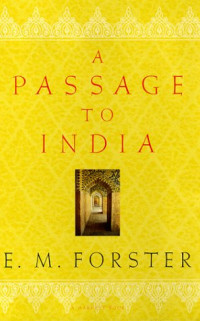De accidental: E. M. Forster, A Passage to India
Title: A Passage to India
Author: E. M. Forster
Publisher: Penguin Books
Edition: 1965
Number of pages: 317 1. To what genre does this novel belong? This book is a novel revolving around colonialism. I think it also has some elements of a picaresque novel in it. 2. Who is the main character? Describe him/her: character, age, looks, etc. I don't think just one person can be pointed out as the main character. I think both Aziz and Miss Quested are the main characters. Therefore I will describe them both. AzizAziz is a young Indian doctor. He first met Mrs. Moore in a mosque in the commencement of the story. He's a very honest man and has virtually no aversion against the British people. He likes Miss Moore quite a lot and takes her out for an excursion to the Marabar Caves. Miss Quested joins this excursion as well. After visiting one cave with Mrs. Moore and Miss Quested, Mrs. Moore feels a little distressed and decides to wait outside while Aziz and
Miss Quested are reconnoitring another cave. Miss Quested
Miss Quested was on a visit from England to the man she anticipated to marry. She showed an honest interest in the Indian culture and ways of life which, was frowned upon by the British community. The English Community in Chandrapore speaks disdainfully about the Indians or the 'natives', as they often tend to call them. When Miss Quested was reconnoitring the second cave with Aziz and a guide, she got lost. Aziz got mad at the guide for losing sight of her and he went outside hoping Miss Quested had found her way out of the cave on her own. Outside at some distance he sees a car starting so he figures that Miss Quested is leaving because she was upset or perhaps fell ill.
3. Does the main character change in the course of the novel? Explain.
Aziz
He doesn't really change in the course of the novel. Although he was probably very upset hearing that he's being charged with attempted assault. Miss Quested
I think she's really pretty quaint. She changes her mind all the time. Every time she ponders over the events in the cave she starts to doubt whether it was Aziz. But when Miss Moore and the others sluice their prejudices about Aziz and the 'natives' in general, she feels a little bit more confident about her decision to charge Aziz. However, I think she's never really sure about whether it was Aziz or someone else who attempted to assault her in the Marabar Caves. 4. How does the book end? Is it an open ending - expected/unexpected ending, etc.? Describe the last scene in some detail. The book ends rather strange. Fielding and Aziz are having an argument. Fielding says that the British Empire's only peer was the Roman Empire. Aziz is yelling that India will be free and that they want to get rid of the English. They grew wiser; India doesn't need the British any more. Aziz says that he wants the Afghans instead of the English because they are his own ancestors. He also says that India's chance to be free will come in the next European War. 5. Where does the story take place? How do you know this? (Mention page number!) The story takes place in the city of Chandrapore in India. This city is located near the river Ganges. See page number 9, line 2. 6. When does the story take place? How do you know this? (Mention page number!) No date, year or decade is mentioned in the novel. The author does, however, mention that the story takes place in the twentieth century. See page number 158, line 22. Forster started writing the book in 1912 but it wasn't published until 1924. Therefore I think it takes place in the `10's or `20's of the twentieth century. This is also ratified by the fact that in those years India was a British Colony. 7. Who tells the story? (The main character, the author,...?) The omniscient narrator (the author) tells the story.
8. Explain the title.
The title is obviously symbolic in its intents. 'The passage to India' unmistakably refers to the 'passage' that Miss Quested made to India.
9. What characters do you think sympathetic, and why? (Or unsympathetic, if you prefer).
On the one side I think Miss Quested really sympathetic but on the other side I find her rather pathetic because she was so upset and ill after her experience in the cave.
I find her sympathetic because she doesn't have any prejudices regarding the Indians and because she treats them as if they were equal to the British people.
10. Did you enjoy reading the novel? Explain!
I enjoyed reading the novel very much. In fact, I experienced reading the book as a mind-expanding activity. The book was at some points rather dull and in the first chapters perhaps even fatuous. But this is almost completely compensated by the further development of the story. I found the book sometimes rather difficult to understand particularly when Forster describes the (main) characters in the book. He does this by means of extremely eloquent dialogues between the characters. Virtually the entire book is written in very eloquent language. The book is full of sophisticated irony, which is sometimes quite difficult to fathom. I would definitely recommend others to read the book so they can expand their minds too. I think I would give the book a 7 ½ as note.
Title: A Passage to India
Author: E. M. Forster
Publisher: Penguin Books
Edition: 1965
Number of pages: 317 1. To what genre does this novel belong? This book is a novel revolving around colonialism. I think it also has some elements of a picaresque novel in it. 2. Who is the main character? Describe him/her: character, age, looks, etc. I don't think just one person can be pointed out as the main character. I think both Aziz and Miss Quested are the main characters. Therefore I will describe them both. AzizAziz is a young Indian doctor. He first met Mrs. Moore in a mosque in the commencement of the story. He's a very honest man and has virtually no aversion against the British people. He likes Miss Moore quite a lot and takes her out for an excursion to the Marabar Caves. Miss Quested joins this excursion as well. After visiting one cave with Mrs. Moore and Miss Quested, Mrs. Moore feels a little distressed and decides to wait outside while Aziz and
Miss Quested are reconnoitring another cave. Miss Quested
He doesn't really change in the course of the novel. Although he was probably very upset hearing that he's being charged with attempted assault. Miss Quested
I think she's really pretty quaint. She changes her mind all the time. Every time she ponders over the events in the cave she starts to doubt whether it was Aziz. But when Miss Moore and the others sluice their prejudices about Aziz and the 'natives' in general, she feels a little bit more confident about her decision to charge Aziz. However, I think she's never really sure about whether it was Aziz or someone else who attempted to assault her in the Marabar Caves. 4. How does the book end? Is it an open ending - expected/unexpected ending, etc.? Describe the last scene in some detail. The book ends rather strange. Fielding and Aziz are having an argument. Fielding says that the British Empire's only peer was the Roman Empire. Aziz is yelling that India will be free and that they want to get rid of the English. They grew wiser; India doesn't need the British any more. Aziz says that he wants the Afghans instead of the English because they are his own ancestors. He also says that India's chance to be free will come in the next European War. 5. Where does the story take place? How do you know this? (Mention page number!) The story takes place in the city of Chandrapore in India. This city is located near the river Ganges. See page number 9, line 2. 6. When does the story take place? How do you know this? (Mention page number!) No date, year or decade is mentioned in the novel. The author does, however, mention that the story takes place in the twentieth century. See page number 158, line 22. Forster started writing the book in 1912 but it wasn't published until 1924. Therefore I think it takes place in the `10's or `20's of the twentieth century. This is also ratified by the fact that in those years India was a British Colony. 7. Who tells the story? (The main character, the author,...?) The omniscient narrator (the author) tells the story.










REACTIES
:name
:name
:comment
1 seconde geleden